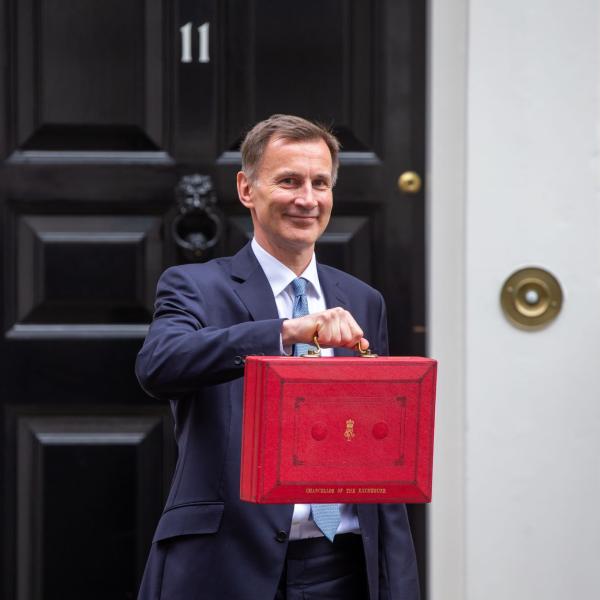Collection

Independent, rigorous analysis of the the Chancellor's Summer Statement of 2020.
Slides from the event
Summer Economic Update: IFS analysis
PDF | 878.84 KB
Paul Johnson
Welcome to our analysis of yesterday’s summer economic statement
My colleagues Carl Emmerson, Rob Joyce and Helen Miller will run through the main elements of the package unveiled in a moment. Let me start with some brief context.
This was another big package. In normal times, even in a normal recession, we would have been taken aback by the scale of measures announced outside of a budget. Up to £30 billion of measures plus £33 billion of public service spending not previously accounted for.
But, of course, this is no normal recession. It’s the deepest in history.
This was as the chancellor said the second, but not final, act in his response.
The first involved spending huge amounts – over £130bn – essentially to respond directly to the virus and preserve the economy as it was. Given the lockdown this was necessary. And being largely about giving money out was relatively straightforward. You can disburse £60 billion through a scheme like CJRS or add £8 billion to the welfare bill quite easily.
The second and subsequent acts are much trickier to deliver and get right. They need to get the balance between preserving those parts of the economy which have a long-term future and helping the transition to a new normal. They also need to actually deliver goods and services and change. That is very different from simply disbursing cash. This phase needs to get several things right.
First there’s timing, timing, timing:
- Timing of when to withdraw support and how quickly. The CJRS can’t last forever. The Chancellor had already settled on a gradual withdrawal through to the end of October. We simply can’t know whether that will be too fast or too slow;
- Timing of when to introduce stimulus measures like the VAT cut for hospitality. Maybe it would have been better to wait until we know whether the real problem is on the demand side – people need to be encouraged to go out and eat – or on the supply side – with social distancing restaurants can’t serve enough people;
- Timing of when to withdraw the new stimulus measures. Will withdrawing the Stamp Duty holiday next March be too early if the economy and housing market are still in the doldrums?
Then there is scale:
- How much is needed? Is £30 billion enough?
- How much can be delivered? This is a better question. It’s much harder to run a kickstart scheme and make sure it is effective than it is to deliver CJRS. The same goes for energy efficiency programmes, apprenticeships and so on. It is not enough to say the spending and programmes should have been bigger. You need to be sure you can deliver them. Even at the scale announced this will be challenging.
- Normally we’d also be asking what can be afforded. Today the question is better posed as what is needed and what can be delivered.
Finally, there is the issue of value for money and additionality. Even in a crisis we shouldn’t ignore the basics:
- A lot, probably a majority, of the job retention bonus money will go in respect of jobs that would have been, indeed already have been, returned from furlough anyway;
- Much of VAT cut and stamp duty cut will be deadweight;
- Committing £15bn for PPE may be necessary, but we can expect expensive equipment.
I expect the next phase, in the Autumn budget, still to be looking to support a recovery. We will know more then about the progress of both the virus and the economy. This should allow for more targeted support. Perhaps more targeted tax cuts, more thought through investment programmes, more developed job support schemes. And, of course, a spending review.
The time to pay for all this will come. But not this year and not next. Our capacity to do so will depend above all on how the economy recovers.
So, our focus today, like the Chancellor yesterday, will be on this support and recovery phase. But let’s hold in the back of our minds that a reckoning, in the form of higher taxes, will come eventually.
Commenting on the Chancellor’s Summer Economic Update Paul Johnson, Director of the Institute for Fiscal Studies, said:
“Prior to today the total value of new measures announced since March was thought to stand at £130 billion. Today the Treasury revised that figure up to nearly £160 billion with £30 billion more being spent on public services, especially health. The Chancellor also set out new measures worth a further £30 billion.
More support may well need to be announced in the Autumn when we know more about the path of the virus and of the economy, but this was another big package from the Chancellor. It was focussed on the right things, such as jobs for the young, but its size in part reflects how hard it is to target resources only where they are really needed. Much of the job retention bonus cash will be paid in respect of employees who would have (or indeed have already) returned to work anyway, for example.”
Public finances and spending on public services: a very substantial set of giveaways
Text attributable to Carl Emmerson, IFS Deputy Director
Public services spending – much more spent than previously thought
“New figures released by the Treasury suggest that the total cost of temporary measures announced since the Budget stood at almost £160 billion, almost £30 billion higher than the latest estimate from the Office for Budget Responsibility of £133 billion. The main difference is that the Treasury has now allocated an additional £49 billion to spending on public services since March, which is £33 billion higher than the OBR’s June estimate. Of this £49 billion over £30 billion has gone to health services – including £15 billion on purchases of Personal Protective Equipment.”
Latest measures to cost up to £30 billion
“The Treasury estimates that the measures announced by the Chancellor Rishi Sunak in today’s statement could have a direct cost of up to £30 billion, with the biggest new giveaway likely to be the payment to employers of £1,000 for every furloughed employee who is kept in their employment. The overall direct cost of fiscal policy measures since March therefore now stands at almost £190 billion, which is equivalent to almost 9% of what the UK economy produced in 2019–20.”
Deficit will keep growing – what comes next will be key
“There is a huge amount of uncertainty around the public finances – but these measures are likely to push the deficit further above £300 billion, which would be easily the highest as a share of national income since the Second World War. Of course this additional borrowing is all currently being borrowed at very low interest rates. What matters more for the public finances will be the extent to which the economy manages to bounce-back strongly. If – as is likely – the economy does not fully recover then future fiscal events are likely to involve a less pleasant set of announcements over the extent to which taxes need to rise to restore the health of the public finances. But those decisions can – and should – be left for another year.”
Labour market measures
Text attributable to Robert Joyce, IFS Deputy Director
A challenge for this set of measures is whether they can help to stimulate long-term, high-quality job matches with good prospects of progression. This will be a part of what is needed if we are to avoid the stagnant productivity and living standards that persisted for so long after the last recession.
Kickstart Scheme
“The £2 billion “Kickstart” scheme will subsidise 6-month work placements for under-25s claiming universal credit and “at risk” of long-term unemployment. Hence the policy is quite well targeted at the young people who are most vulnerable, and whose other options will often be rather bleak. Indeed, the scheme shares many features with the Future Jobs Fund introduced by the Labour Government during the last recession, which had lasting positive impacts on the employment of those employed under the scheme.”
“The structure of the subsidy means that incentives to offer these placements are sharpest for low-paid, part-time, temporary work. The risk is that this is not a great recipe to “kick start” high quality careers. Much will depend on how the rest of the labour market bounces back. Putting people on the bottom rung of the jobs ladder will only be a stepping stone to something more if job vacancies soon open up further up the ladder.”
Job Retention Bonus
“The government is offering a £1,000 bonus to employers who bring back previously-furloughed employees and employ them until at least January, as long as they earn at least £520 per month over that period. Because this is a fixed cash amount, it is again a policy that will have the sharpest impact on incentives to employ the lowest-paid workers.”
“The measure is a recognition that, while the furlough scheme ends in October, continued weakness in labour demand will persist beyond that. The hope is that by February things are significantly better, and that by reducing employers’ labour costs in the meantime fewer jobs that still have long-term value will be destroyed. Unfortunately for many workers at risk of unemployment – particularly those not on the lowest earnings – this subsidy won’t be enough to tip the balance on its own. For the rest, it remains to be seen whether this will just push the problem further back and leave the government with a similar dilemma as February approaches. “
Measures to get the economy moving again
Text attributable to Helen Miller, IFS Deputy Director
Support for hospitality sector – a lot depends on whether firms can accommodate more customers
“The tourism and hospitality sectors have been particularly badly affected by the crisis. Cutting VAT and discounting restaurant meals will increase output in these sectors if businesses have the capacity to serve more customers despite social distancing requirements. However, social distancing will remain a constraint in many cases, and here the measures will simply be a giveaway to consumers and firms – a giveaway not targeted at those who are struggling most.”
“Only last week, the risk of virus transmission was deemed sufficiently serious that there was a ban on eating in restaurants; as it stands, the August discount scheme makes it cheaper relative to takeaways. Putting takeaways in scope would be more effective in increasing output without compromising social distancing.”
Energy efficiency vouchers – could have some long run benefits if taken up
“There is ample scope for most UK households to become more energy efficient and this could have benefits in the long run, both for emissions and for household budgets. There is a risk that the scheme will lead to inflated prices of energy efficiency equipment, particularly if the scope of eligible spending is narrow.”
SDLT holiday – well targeted at getting the housing market moving, which in turn will boost spending
“Stamp duty is a damaging tax in normal times and acts to reduce the number of transactions; the holiday will boost transactions and provide a stimulus through the additional spending that is associated with moving house.”
“The holiday is due to end in March 2021. If the economy is still not recovered and if people have bought forward transactions, this could lead to a depression of housing sales while the economy is still weak.”
Our analysis of the Summer Economic Update is funded by UK Research and Innovation (grant no. ES/V00381X/1). We are also grateful for funding from the ESRC-funded Centre for the Microeconomic Analysis of Public Policy (ES/M010147/1).
Our analysis of the Summer Economic Update is funded by UK Research and Innovation (grant no. ES/V00381X/1). We are also grateful for funding from the ESRC-funded Centre for the Microeconomic Analysis of Public Policy (ES/M010147/1).
Collection details
- Publisher
- IFS
More from IFS
Understand this issue

Empty defence spending promises are a shot in the dark
29 April 2024

Public investment: what you need to know
25 April 2024

The £600 billion problem awaiting the next government
25 April 2024
Policy analysis

Spring Budget 2024
6 March 2024

Scottish Budget 2024–25
22 February 2024

Autumn Statement 2023
22 November 2023
Academic research

6th World Bank/IFS/ODI Public Finance Conference | Driving Progress: Public Finance and Structural Transformation

Inaugural IFS postdoc workshop
